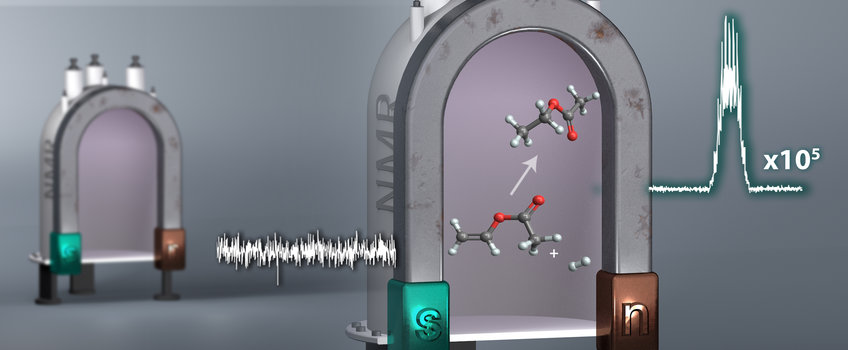
NMR Signal Enhancement
Nuclear magnetic resonance (NMR) is a phenomenon that has widely influenced our world. Applications connect different fields of science ranging from fundamental physics and materials science to the determination of chemical structures and biomedicine. We are interested in enhancing inherently weak NMR signals allowing for more sensitive detection methods and improved investigation of diseases. Our focus is nuclear hyperpolarization. Methods are available to boost NMR signal intensities by over four orders of magnitude opening up new possibilities for medical diagnostics. We are also exploring new molecular structures to prolong NMR lifetimes in the form of nuclear singlet states and utilize them as contrast agents. Singlet states are “NMR-silent-states” which offer the opportunity to store hyperpolarization for over one hour, exceeding the 2-3 minute limitations with current hyperpolarized in vivo tracers. Our activities in more detail are as follows:
Hyperpolarization: Metabolic probes and catalysts for biological sciences
Hyperpolarization can be used to enhance the signal strength of metabolites and probe their metabolism in vivo. The detection of an altered metabolism may lead to the identification of disease-related processes, which can serve as diagnostics or to broaden our scientific understanding. We are developing precursors of metabolites that can be hyperpolarized, in particular with para-hydrogen, and transformed into a metabolic tracer. Para-hydrogen is a nuclear isomer of molecular hydrogen in a singlet state. In the presence of a catalyst and target molecule, this singlet state can be converted into observable hyperpolarization which allows for the development of new imaging contrast agents. In the past, we have managed to hyperpolarize amino acid derivatives and subsequently simple amino acids such as glycine and alanine. In addition, we are focusing on the development and investigation of hydrogenation catalysts that can efficiently convert the singlet order of para-hydrogen into hyperpolarization. The main goal is to develop heterogeneous catalysts that can be easily removed after hydrogenation/hyperpolarization of a metabolite to mitigate toxicity concerns. Our recent investigations have lead to the discovery of ligand-capped nanoparticles that show improved hyperpolarization using water as a biocompatible solvent. We have discovered that the ligands surrounding a nanoparticle can have a strong effect on the conversion of singlet order into hyperpolarization. Understanding this process, improving nanocatalyst performance and the combination of hyperpolarization techniques with metabolic contrast agents will lead to an inexpensive way to generate metabolic contrast agents in the future.
Singlet-States: From a quantum state to molecular agents
Nuclear singlet states can be populated in a variety of molecules and are not only limited to para-hydrogen. Research on singlet states has received considerable attention since it is a promising approach to prolong hyperpolarized tracer lifetimes. In order to improve the lifetime of these tracers, we synthesize and explore molecules with highly symmetric properties necessary to maintain a long-lived singlet-state and allow for hyperpolarization with para-hydrogen. Additionally, we are exploring molecules with singlet-states for use in biological applications such as in vitro tracers in cells or proteins and for magnetic resonance imaging (MRI).
![[Fe]-hydrogenase catalysis visualized using para-hydrogen-enhanced nuclear magnetic resonance spectroscopy](/4868136/teaser-1734084319.jpg?t=eyJ3aWR0aCI6MjYzLCJoZWlnaHQiOjE3NSwiZml0IjoiY3JvcCIsImZpbGVfZXh0ZW5zaW9uIjoianBnIiwib2JqX2lkIjo0ODY4MTM2fQ%3D%3D--4013432fe94b5cb68bdf2e5dc739fda9564f776f)



